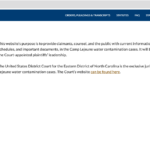Decades of Deceit: A Deep Dive into Camp Lejeune History
This article provides a detailed analysis of the complex history of Camp Lejeune, shedding light on past controversies and environmental crises.

Paying particular attention to the mid-century scandals and water contamination incident, it delves into government responses and public outrage.
The ongoing impacts underline a legacy marked by deceit, drawing on extensive research to unravel this intricate narrative.
Key Takeaways
- Camp Lejeune was established in the 1940s as a central training hub for marine forces during World War II, boasting unique features such as an extensive beachfront for amphibious assault practices.
- The mid-century scandals and controversies at Camp Lejeune involved leadership failures, breaches in military ethics, disregard for safety concerns about contaminated water sources, and a lack of effective oversight and accountability measures.
- The water contamination incident at Camp Lejeune was one of the largest in U.S. history, resulting in a wide range of illnesses and birth defects. Lawsuits were filed against government bodies and private companies responsible for the contamination.
- The government initially denied responsibility for the water contamination incident, but the Janey Ensminger Act was passed in 2012 to acknowledge government accountability. The act provides medical care for affected individuals, and the Department of Veterans Affairs established compensation measures. However, lingering health issues among exposed populations and their progeny continue.
Unveiling the Origins of Camp Lejeune

An in-depth examination reveals key founding figures instrumental in shaping the trajectory of Camp Lejeune. Among these was Major General John A. Lejeune, whose distinguished service and leadership formed a substantial part of the inspiration behind naming this facility after him. Other notable individuals include Lieutenant Colonel William P.T Hill, who played an integral role in selecting the site for this strategic installation.
Lejeune's establishment was met with logistical challenges including rapid construction timelines and resource allocation during war times. Despite such obstacles, it emerged as one of the most comprehensive marine training facilities globally, boasting unique features like an extensive beachfront suitable for amphibious assault practices.
However, controversies also shadowed its success stories right from the beginning stage. Land acquisition disputes arose between local inhabitants and military authorities causing social upheavals which still reverberate in historical discourse surrounding Camp Lejeune.
Thus, understanding the origins of Camp Lejeune requires consideration not only of its achievements but also an examination of contentious issues associated with its foundation. This dual perspective allows for a more holistic understanding by acknowledging both the triumphs and tribulations that characterized its formative years.
Chronology of Controversies: The Mid-Century Scandals
Mid-century scandals mark a significant chapter in the chronology of controversies, demanding an extensive investigation for a clearer understanding.
A critical examination of these incidents reveals substantial leadership failures and breaches in military ethics at Camp Lejeune during this period. Details from various historical records indicate that there was a distinct lack of effective oversight and accountability measures within the camp's command structure. This led to numerous instances where individuals with power acted without considering the potential consequences or ethical implications of their actions.
One such controversy involved senior officers disregarding safety concerns about contaminated water sources within the camp, leading to widespread health issues among personnel and their families. Further analysis shows that another area where leadership failed was in maintaining transparency and communication with those affected by these decisions. Instead of acknowledging the problem and taking responsibility for it, Camp Lejeune's administration chose to obfuscate facts, denying any wrongdoing until irrefutable evidence came to light.
The examination also showcases how these actions contravened military ethics, which stipulates a duty of care towards all personnel. The lackadaisical attitude towards safety regulations not only endangered lives but also eroded trust within ranks, ultimately undermining morale.
Environmental Crisis at Camp Lejeune: The Water Contamination Incident

Undeniably, one of the most egregious incidents during this period was the water contamination crisis at Camp Lejeune. This military base was home to thousands of soldiers and their families and became the site of what is considered one of the largest water contamination events in U.S. history.
The health implications arising from this disaster are far-reaching and severe. From 1953 until 1987, inhabitants were exposed to drinking water tainted with industrial solvents, benzene, and other harmful chemicals linked to a wide range of illnesses including various forms of cancer, neurological disorders, and birth defects. It is estimated that nearly one million people may have been affected by this mass poisoning.
Legal actions ensued as knowledge about the magnitude of the problem came into focus. Lawsuits were filed against both federal government bodies and private companies alleged to be responsible for dumping toxic waste into groundwater supplies feeding into Camp Lejeune's wells. In response to mounting public pressure and overwhelming scientific evidence linking exposure to these contaminants with serious health issues, Congress passed The Janey Ensminger Act in 2012. This legislation acknowledged government accountability for failing to protect those residing on base from contaminated water exposure.
The Aftermath: Government Response and Public Outrage

Public outrage ensued in the aftermath of the Camp Lejeune water contamination crisis, prompting a response from the government. This public health disaster, exposed countless residents and military personnel to contaminated drinking water, leading to numerous health-related complications. The government's reaction was marked by both an official denial of responsibility and subsequent policy changes.
Swift action followed the initial official denial. The legislative arm of the government enacted several policies aimed at addressing this public health catastrophe. In 2012, Congress passed the Janey Ensminger Act, named after a nine-year-old girl who died from leukemia linked to tainted water exposure at Camp Lejeune. This law entitled affected individuals living on base between 1957 and 1987 to medical care for certain illnesses believed to be caused by the polluted water.
The Department of Veterans Affairs (VA) also responded with measures designed to compensate victims. It established a list of presumptive conditions associated with exposure to toxic substances in the contaminated water supply at Camp Lejeune. These actions were instrumental in offering relief to thousands affected by this monumental environmental crisis.
However, despite these efforts, many critics argue that more robust measures are necessary due to lingering health issues among exposed populations and their progeny. There are calls for further studies into the long-term effects of exposure and potential genetic implications that may have a transgenerational impact.
Ongoing Impacts: The Legacy of Deceit at Camp Lejeune
The enduring impacts of the water contamination crisis at the military base continue to raise serious concerns, reflecting a legacy characterized by government deception and lackluster accountability. Health ramifications from this crisis are widespread and severe, with individuals suffering from various diseases such as leukemia, liver disease, and neurological disorders among others. The contaminated drinking water is believed to have resulted in an estimated 1 million people being exposed to toxic chemicals over three decades.
These health ramifications have caused significant distress for victims who were largely unaware of the contamination until years after exposure. Furthermore, the long-term effects are still unfolding as more information regarding the extent of contamination becomes available.
Legal implications also add another layer to this ongoing issue. Although lawsuits have been filed against various entities involved including federal agencies and private companies responsible for maintaining the water supply system at Camp Lejeune, achieving justice has proven difficult due to statutory limitations on claims and immunity provisions that protect government entities from liability.
Moreover, despite efforts by both governmental bodies and non-profit organizations to provide medical care for affected individuals, there remains a significant gap in addressing these health issues fully. This is partly due to bureaucratic hurdles that impede access to necessary healthcare services.
Frequently Asked Questions
What Is the Current Condition of Water Quality at Camp Lejeune?
The current water quality at Camp Lejeune has greatly improved following a comprehensive contamination timeline and implementation of remediation strategies, yet ongoing monitoring is essential to ensure the continued safety of its inhabitants.
Are There Any Health Effects Still Being Discovered That Could Be Linked to the Contamination Incident?
Investigations into contamination origins at Camp Lejeune continue to reveal potential health effects. Ongoing research seeks to link these findings with prior exposure incidents, while legal implications remain a topic of significant deliberation.
What Measures Are Being Taken to Prevent Such Incidents From Occurring in the Future at Military Bases?
Prevention policies have been instituted and modernized infrastructure implemented at military bases to avert future contamination incidents. These measures include stringent guidelines, continuous monitoring, and advanced waste disposal systems to ensure environmental safety.
How Has the Scandal Affected the Reputation and Trustworthiness of the U.S. Military Among the General Public and Veterans?
The scandal significantly impacted military transparency, leading to a progressive deterioration of public perception. Trustworthiness among the general public and veterans was compromised, necessitating major efforts to restore confidence in U.S. military operations and conduct.
What Compensation or Support Is Being Provided to the Victims of the Water Contamination Incident at Camp Lejeune?
Victims of the Camp Lejeune water contamination incident receive healthcare costs through the Veterans Administration. Legal ramifications have led to victim advocacy for additional compensation, though this remains a contentious issue under review.
Conclusion
The historical trajectory of Camp Lejeune reveals a series of controversies and environmental crises that have had long-lasting implications.
The water contamination incident stands as a critical event in this history, given its devastating impacts on health and safety.
Despite government responses and public outrage, the legacy of deceit at Camp Lejeune endures, serving as a stark reminder of institutional neglect and the dire need for transparency in military operations.




